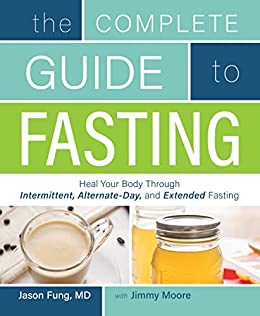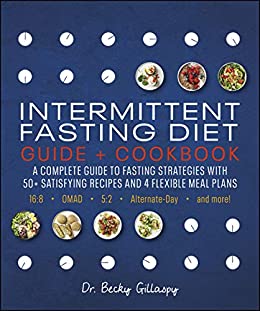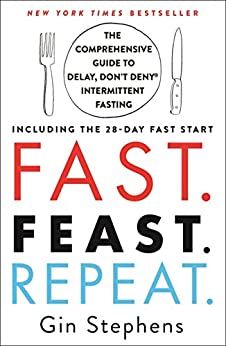Fasting has gained popularity as an effective strategy for weight loss. It involves voluntarily abstaining from food for a specific period of time, allowing the body to utilize stored fat for energy. This article will guide you through the process of fasting for weight loss, providing valuable insights and practical tips to help you achieve your fitness goals.
Introduction to Fasting for Weight Loss
Fasting has been practiced for centuries, not only for religious and spiritual reasons but also for its potential health benefits. In the context of weight loss, fasting can be an effective tool to create a calorie deficit and kickstart your body’s fat-burning mechanisms.

Complete Guide To Fasting: Heal Your Body Through Intermittent, Alternate-Day, and Extended Fasting
Understanding the Concept of Fasting
Fasting involves voluntarily restricting calorie intake for a specific duration. It can be done in different ways, including intermittent fasting, alternate-day fasting, and extended fasting. The primary objective is to allow your body to enter a state of ketosis, where it starts burning stored fat for fuel.
Different Types of Fasting Methods
- Intermittent Fasting (IF): This method involves cycling between periods of eating and fasting. Popular IF approaches include the 16/8 method (fasting for 16 hours and eating within an 8-hour window) and the 5:2 diet (eating normally for five days and restricting calories for two non-consecutive days).
- Alternate-Day Fasting: This method involves fasting every other day or significantly reducing calorie intake on fasting days.
- Extended Fasting: This approach involves fasting for more extended periods, typically 24 hours or more.
Benefits of Fasting for Weight Loss
Fasting offers several benefits beyond weight loss. It can improve insulin sensitivity, boost metabolism, reduce inflammation, and promote cellular repair. Additionally, fasting may enhance mental clarity and focus.

Intermittent Fasting Diet Guide and Cookbook: A Complete Guide to Fasting Strategies with 50+ Satisfying Recipes and 4 Flexible Meal Plans: 16:8, OMAD, 5:2, Alternate-day, and More
Preparing for a Fast
Before starting a fast, it’s essential to consult with a healthcare professional, especially if you have any underlying health conditions. Additionally, ensure you have a clear understanding of the chosen fasting method and prepare yourself mentally and physically for the upcoming journey.
Implementing a Fasting Schedule
Create a fasting schedule that suits your lifestyle and preferences. Experiment with different fasting methods to find the one that works best for you. Start with shorter fasting durations and gradually increase them as you become more comfortable.
Managing Hunger and Cravings during Fasting
Hunger and cravings are common challenges during fasting. Stay hydrated, consume calorie-free beverages like water, tea, or coffee, and distract yourself with activities to curb hunger. Planning meals ahead for non-fasting periods can also help manage cravings effectively.

Intermittent Fasting For Beginners: A Complete Guide to the Fasting Lifestyle
Combining Fasting with a Healthy Diet
While fasting can lead to weight loss, it’s crucial to follow a healthy diet during non-fasting periods. Focus on whole foods, including lean proteins, fruits, vegetables, and whole grains. Avoid excessive calorie intake or overcompensating for fasting periods.
Exercise during Fasting
Exercise can complement fasting by enhancing weight loss and preserving muscle mass. Engage in light to moderate-intensity workouts during fasting, such as brisk walking, yoga, or low-impact cardio exercises. Listen to your body and adjust the intensity accordingly.
Monitoring Progress and Adjusting the Fasting Routine
Track your progress by monitoring your weight, body measurements, and overall well-being. Adjust your fasting routine if necessary, based on your goals and how your body responds. Remember that consistency is key, and sustainable weight loss takes time.
Safety Considerations when Fasting
Fasting may not be suitable for everyone. If you’re pregnant, breastfeeding, have certain medical conditions, or take specific medications, it’s crucial to consult with a healthcare professional before embarking on a fasting journey. Listen to your body and prioritize your well-being.
Breaking the Fast Properly
When breaking a fast, start with small, easily digestible meals to allow your body to readjust to food intake gradually. Focus on nutrient-dense foods and avoid overeating. Take your time to chew thoroughly and savor each bite.
Sustaining Weight Loss after Fasting
Fasting can kickstart weight loss, but maintaining it requires adopting healthy lifestyle habits. Focus on a balanced diet, regular physical activity, adequate sleep, and stress management. Be mindful of your eating patterns and make sustainable choices.

Fast. Feast. Repeat.: The Comprehensive Guide to Delay, Don’t Deny® Intermittent Fasting–Including the 28-Day FAST Start
Conclusion
Fasting can be a powerful tool for weight loss when done correctly and safely. It offers numerous benefits beyond shedding pounds, including improved metabolic health and increased mental clarity. Remember to consult with a healthcare professional before starting a fasting regimen and listen to your body throughout the process.
FAQs
Is fasting safe for everyone?
Fasting may not be suitable for pregnant women, breastfeeding mothers, individuals with certain medical conditions, or those taking specific medications. Consult with a healthcare professional before fasting.
Will fasting cause muscle loss?
Properly executed fasting methods, combined with regular exercise, can help preserve muscle mass while promoting fat loss.
Can I drink water during fasting?
Yes, staying hydrated is crucial during fasting. Drink water, herbal tea, or black coffee without sugar or cream.
How long does it take to see results from fasting?
The results vary depending on individual factors such as starting weight, metabolism, and fasting duration. It may take several weeks to notice significant changes.
Can I fast while exercising?
Yes, moderate-intensity exercises can be performed during fasting. However, listen to your body, and adjust the intensity if needed.
Fasting for weight loss requires dedication and discipline, but it can be a rewarding journey towards achieving your health and fitness goals. Remember to listen to your body throughout the process and make adjustments as needed. It’s important to approach fasting with a balanced mindset and focus on the long-term benefits rather than quick fixes. Combine your fasting routine with regular exercise and a nutritious diet to maximize results. Stay motivated by tracking your progress and celebrating milestones along the way. Embrace the positive changes that come with fasting, such as improved energy levels, increased self-awareness, and a sense of accomplishment. With patience, determination, and a well-planned fasting approach, you can embark on a successful weight loss journey and enjoy the transformative benefits of fasting for a healthier and happier life.
